 |
 |
 |
| |
FDA-Approved Chemotherapeutic Drugs that Inhibit
VEGF, RAF-1, B-RAF and the Proteosome Reverse HIV-1
Latency Without Global T cell Activation
|
| |
| |
Reported by Jules Levin
22nd International AIDS Conference; Amsterdam, The Netherlands; 23-27 July 2018
I. Munoz-Arias1, E. Gibson1, E. Hanhauser1, G. Wu2, C. Thanh1, M.A. Mohsen3, L. Hogan1,
K. Hobbs1, B. Howell2, S. Pillai3, S. Deeks4, T. Henrich1
1University of California at San Francisco, Department. of Experimental Medicine, San Francisco, US, 2Merck Sharp & Dohme Research Laboratories, Department of Infectious Diseases, Kenilworth, NJ, USA, 3Blood Systems Research Institute, UCSF, San Franscisco, CA, US, 4University of California at San Francisco, SCOPE Cohort and Department of Experimental Medicine, San Francisco, US
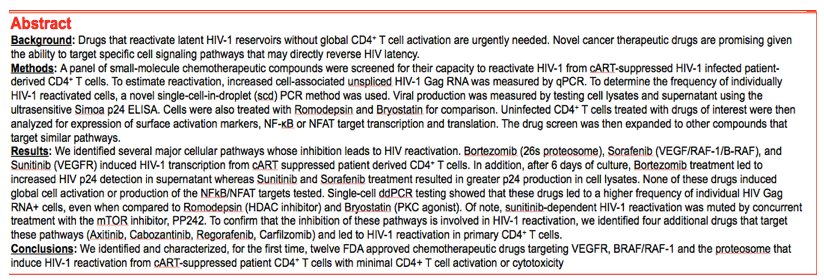
in case the above is hard to read here is the text........
Abstract
Background: Drugs that reactivate latent HIV-1 reservoirs without global CD4+ T cell activation are urgently needed. Novel cancer therapeutic drugs are promising given the ability to target specific cell signaling pathways that may directly reverse HIV latency.
Methods: A panel of small-molecule chemotherapeutic compounds were screened for their capacity to reactivate HIV-1 from cART-suppressed HIV-1 infected patient-derived CD4+ T cells. To estimate reactivation, increased cell-associated unspliced HIV-1 Gag RNA was measured by qPCR. To determine the frequency of individually HIV-1 reactivated cells, a novel single-cell-in-droplet (scd) PCR method was used. Viral production was measured by testing cell lysates and supernatant using the ultrasensitive Simoa p24 ELISA. Cells were also treated with Romodepsin and Bryostatin for comparison. Uninfected CD4+ T cells treated with drugs of interest were then analyzed for expression of surface activation markers, NF-κB or NFAT target transcription and translation. The drug screen was then expanded to other compounds that target similar pathways.
Results: We identified several major cellular pathways whose inhibition leads to HIV reactivation. Bortezomib (26s proteosome), Sorafenib (VEGF/RAF-1/B-RAF), and Sunitinib (VEGFR) induced HIV-1 transcription from cART suppressed patient derived CD4+ T cells. In addition, after 6 days of culture, Bortezomib treatment led to increased HIV p24 detection in supernatant whereas Sunitinib and Sorafenib treatment resulted in greater p24 production in cell lysates. None of these drugs induced global cell activation or production of the NFkB/NFAT targets tested. Single-cell ddPCR testing showed that these drugs led to a higher frequency of individual HIV Gag RNA+ cells, even when compared to Romodepsin (HDAC inhibitor) and Bryostatin (PKC agonist). Of note, sunitinib-dependent HIV-1 reactivation was muted by concurrent treatment with the mTOR inhibitor, PP242. To confirm that the inhibition of these pathways is involved in HIV-1 reactivation, we identified four additional drugs that target these pathways (Axitinib, Cabozantinib, Regorafenib, Carfilzomib) and led to HIV-1 reactivation in primary CD4+ T cells.
Conclusions: We identified and characterized, for the first time, twelve FDA approved chemotherapeutic drugs targeting VEGFR, BRAF/RAF-1 and the proteosome that induce HIV-1 reactivation from cART-suppressed patient CD4+ T cells with minimal CD4+ T cell activation or cytotoxicity.
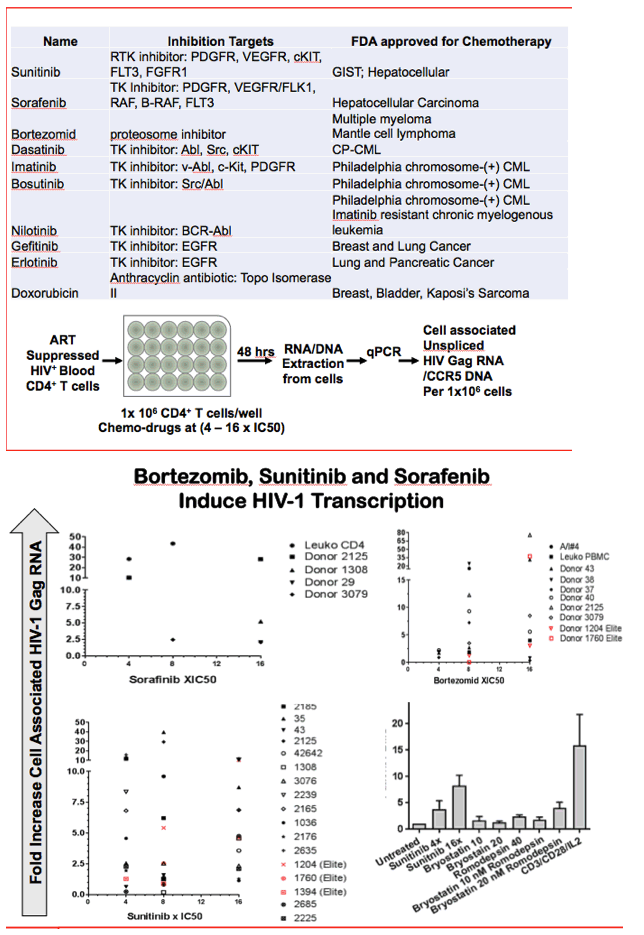
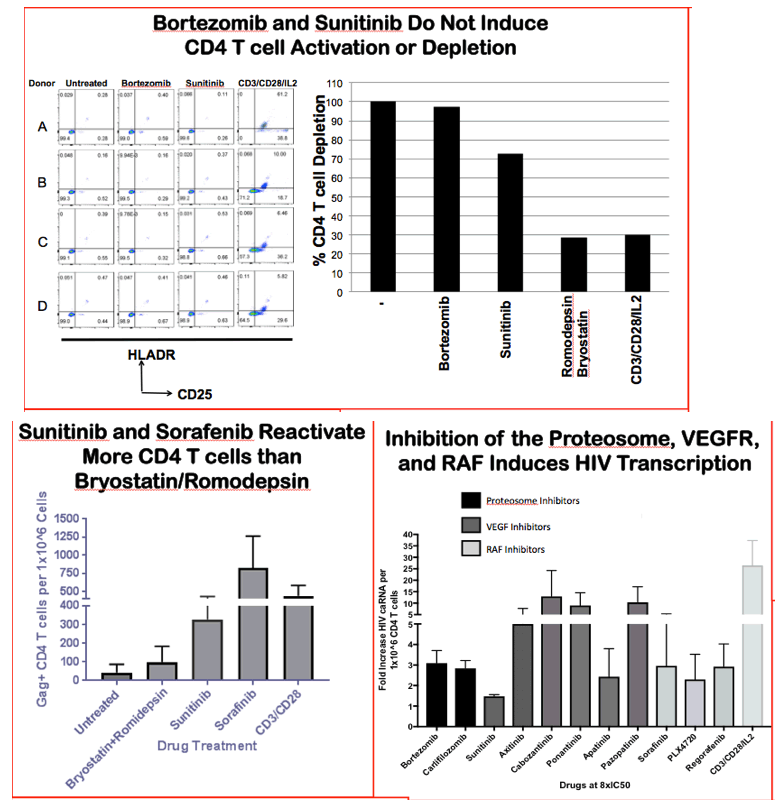
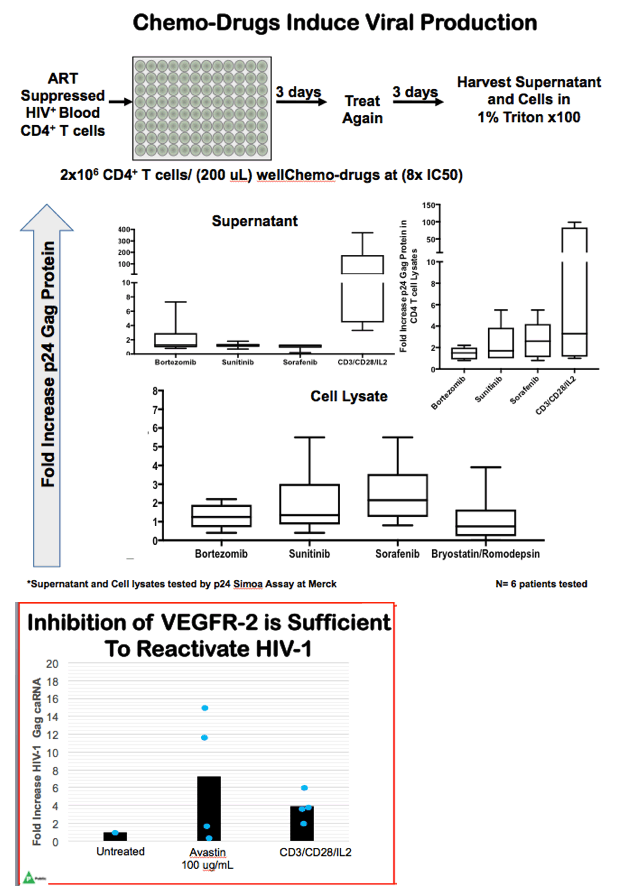
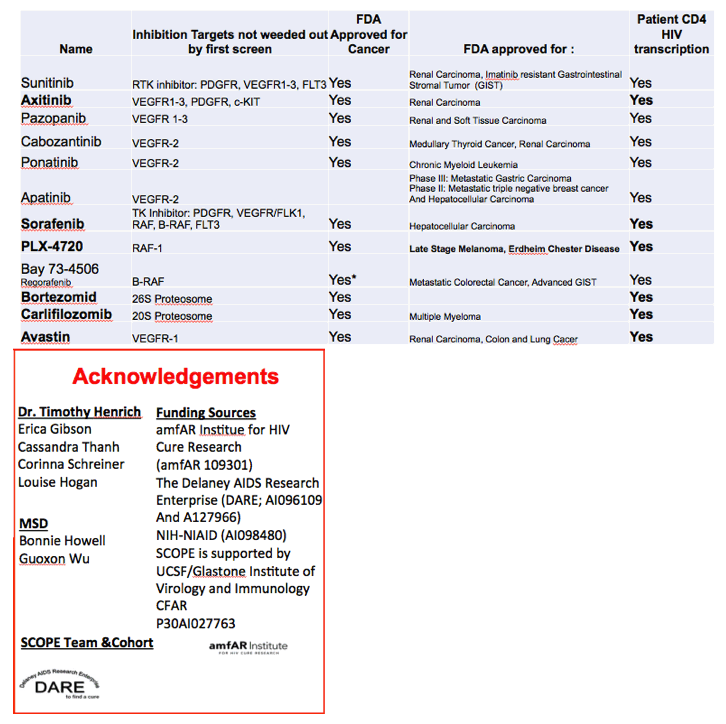
|
| |
|
 |
 |
|
|